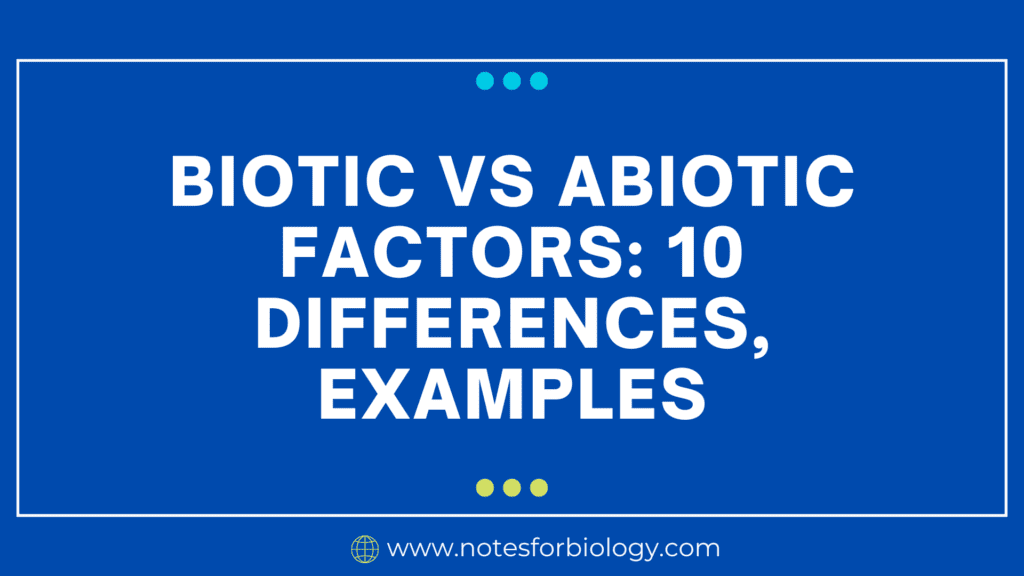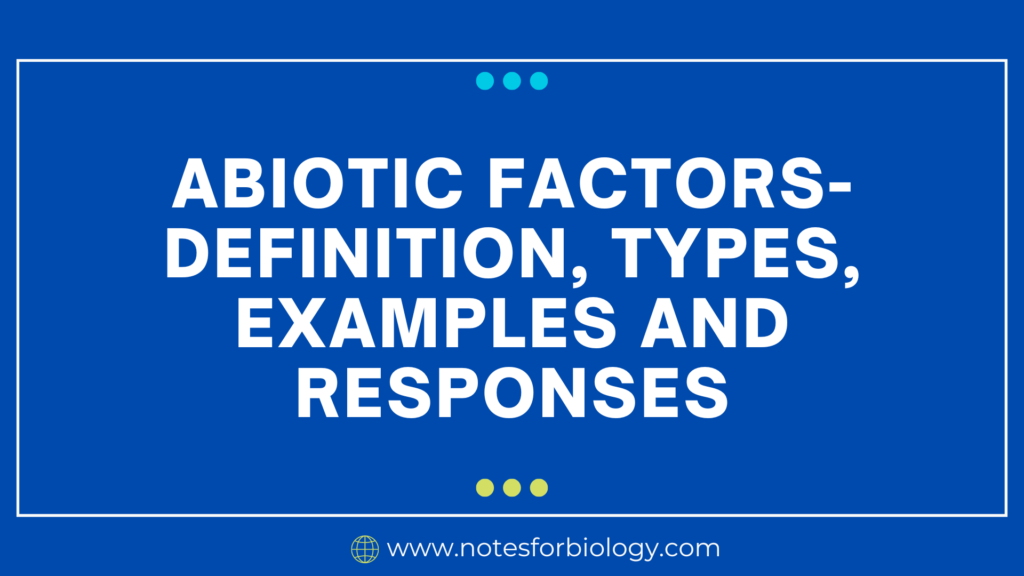Understanding the components that drive ecosystems is critical in ecology research, and one crucial idea is Biotic vs Abiotic Factors. Biotic influences include all living organisms, from the smallest bacterium to the greatest mammals, which interact in complicated ways. In contrast, abiotic factors are nonliving components such as sunlight, water, and soil that supply the necessary circumstances for life. The interaction of biotic and abiotic variables dictates the structure, function, and dynamics of ecosystems. By exploring the differences between Biotic vs Abiotic Factors and examples of these components, we get insight into the complex web of life and the fundamental processes that keep it going.
Table of Contents
Biotic Factors
A biotic factor is defined as any living component that influences the population of another organism or the environment within an ecosystem. This covers all species that interact with one another and their surroundings, including plants, animals, bacteria, fungus, and other living things. Biotic factors play important roles in processes like as predation, competition, symbiosis, and nutrient cycling, which all contribute to ecosystem balance and dynamics.
Examples:
Plants: Trees, shrubs, grasses, and aquatic plants.
Animals: Mammals, birds, reptiles, amphibians, fish, and insects.
Microorganisms: Bacteria, archaea, and protozoa.
Fungi: Mushrooms, molds, and yeasts.
Humans: Homo sapiens and their effects on ecosystems via activities such as agriculture and urbanization.

Abiotic Factors
An abiotic factor is any non-living physical or chemical component of an ecosystem that has an effect on the live creatures. These variables include sunlight, temperature, water, soil, air, minerals, and pH. Abiotic variables offer the necessary circumstances and resources for life to exist, impacting organismal growth, survival, and reproduction. They play an important role in structuring habitats and ecosystems by deciding which creatures can flourish in a specific environment.
Examples:
Sunlight: It is the primary energy source for photosynthesis.
Temperature: Influences metabolic rates and the dispersal of organisms.
Water: Is essential for all life; it regulates plant development and habitat conditions.
Soil: It contains nutrients and serves as a substrate for plant roots.
Air: Provides oxygen for respiration and carbon dioxide for photosynthesis.
Minerals: Include essential minerals such as nitrogen, phosphorus, and potassium.
Climate: Long-term weather patterns that affect ecosystems.
pH: Influences the availability of nutrients in soil and water.
Salinity: Influences the types of creatures that can thrive in watery habitats.
Humidity: Influences the rate of evaporation and transpiration in plants.

Biotic vs Abiotic Factors
Biotic vs Abiotic Factors play important roles in ecosystems, regulating organism survival, growth, and reproduction. Understanding the distinctions between Biotic vs Abiotic Factors is critical for studying ecological interactions and environmental science.
The differentiation between Biotic vs Abiotic Factors are:
| S.No. | Biotic Factors | S.No. | Abiotic Factors |
| 1. | Biotic Factors are the living components of an ecosystem, which include plants, animals, fungi, bacteria, and protozoa. | 1. | Abiotic Factors are the non-living physical and chemical components of an ecosystem, including sunshine, temperature, water, soil, and minerals. |
| 2. | Biotic factors are organic and dynamic, capable of reproduction, growth, and evolution. | 2. | Abiotic factors are inorganic and static, unable to support life processes. |
| 3. | Plants rely on abiotic elements to survive. | 3. | Abiotic variables influence but are not dependent on biotic factors. |
| 4. | Engage in energy flow and nutrient cycling through processes such as predation, decomposition, and photosynthesis. | 4. | provide the required conditions for the existence of biotic factors (for example, climate determines the types of creatures that can dwell in a certain location). |
| 5. | Biotic factors include population density, biomass, and species diversity. | 5. | Abiotic factors are measured using physical parameters as temperature, pH, salinity, and moisture content. |
| 6. | Biotic factors include trees, animals, bacteria, fungi, and algae. | 6. | Abiotic factors include sunlight, air, water, minerals, and temperature. |
| 7. | Changes can cause ecological succession, affecting community structure and species composition. | 7. | Changes in habitat circumstances can have an impact on the viability of biotic factors (for example, climate change can affect species distribution). |
| 8. | Biotic factors interact through predation, symbiosis, and competition. | 8. | Interact primarily through physical processes like weathering, erosion, and the water cycle. |
| 9. | Biotic factors frequently shift seasonally or over shorter time periods due to life cycles and reproductive tendencies. | 9. | Abiotic factors tend to change slowly, impacted by geological and climatic processes. |
| 10. | Organisms adapt to their surroundings through natural selection and evolution. | 10. | They do not adapt, they change through natural processes like erosion, volcanic activity and the hydrological cycle. |
To summarize, understanding Biotic vs Abiotic Factors is critical for understanding how ecosystems work and maintain equilibrium. Biotic variables, which comprise all living organisms, interact in intricate ways to shape population dynamics, community structures, and ecosystem processes. Abiotic variables, which include nonliving components like as sunshine, water, and soil, produce the conditions required for life and affect the ecosystems in which organisms live. The interplay of these elements influences ecosystem health, sustainability, and diversity. By researching both Biotic vs Abiotic Factors, we obtain vital insights into the natural world and the intricate relationships that allow life to exist on Earth. Understanding Biotic vs Abiotic Factors helps us comprehend the essential dynamics and health of ecosystems.
Frequently Asked Questions (FAQ)
What are the biotic factors?
Biotic factors are the living parts of an ecosystem, such as plants, animals, bacteria, fungus, and other species.
What are the abiotic factors?
Abiotic factors are the non-living physical and chemical components of an ecosystem, including sunshine, temperature, water, soil, and minerals.
What happens when a biotic element is removed from an ecosystem?
Eliminating a biotic element can disrupt food chains, reduce biodiversity, and change ecosystem dynamics.
Related Articles


